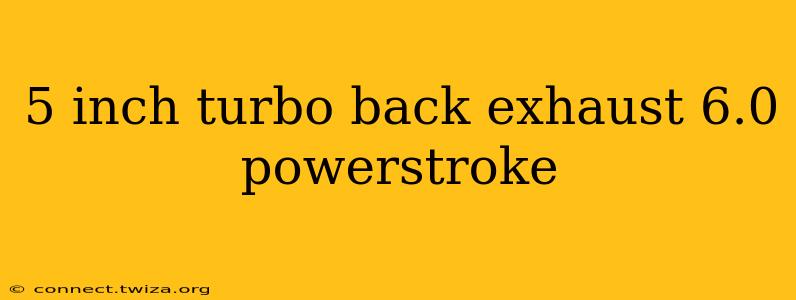The 6.0 Powerstroke engine, a powerhouse in its own right, can be significantly enhanced with the right modifications. One popular upgrade that dramatically improves performance and sound is a 5-inch turbo-back exhaust system. This comprehensive guide explores the benefits, considerations, and frequently asked questions surrounding this popular modification.
What is a 5-Inch Turbo-Back Exhaust System?
A 5-inch turbo-back exhaust system replaces all exhaust components from the turbocharger outlet to the tailpipe with larger diameter piping. This contrasts with smaller exhaust systems that might only replace sections of the exhaust, such as the downpipe. The larger diameter allows for significantly improved exhaust gas flow, leading to increased horsepower, torque, and potentially better fuel economy. The "turbo-back" designation means the system starts after the turbocharger, leaving the pre-turbo components untouched.
Benefits of a 5-Inch Turbo-Back Exhaust on a 6.0 Powerstroke
-
Increased Horsepower and Torque: The reduced backpressure from the larger diameter piping allows the engine to breathe more easily, resulting in noticeable gains in horsepower and torque throughout the power band. This translates to improved acceleration and towing capacity.
-
Improved Turbocharger Response: With less restriction, the turbocharger works more efficiently, leading to quicker spool-up and reduced turbo lag. This makes the truck feel more responsive and powerful.
-
Enhanced Fuel Economy (Potentially): While not always guaranteed, a properly designed 5-inch turbo-back exhaust can lead to slight improvements in fuel economy by optimizing exhaust gas flow.
-
Aggressive Sound: Many enthusiasts choose a 5-inch system for the distinct, deep rumble it produces. The sound is significantly more pronounced than with smaller diameter exhaust systems.
What are the Downsides of a 5-Inch Turbo Back Exhaust?
-
Cost: 5-inch turbo-back exhaust systems are typically more expensive than smaller diameter systems due to the larger amount of material required.
-
Increased Drone: The larger diameter can lead to increased exhaust drone, particularly at certain RPM ranges. This is a subjective issue, and some find the sound desirable, while others find it annoying.
-
Ground Clearance: The larger diameter pipes might affect ground clearance, depending on the specific system and the truck's modifications.
-
Installation Complexity: Installing a 5-inch turbo-back system can be more complex than installing a smaller system, potentially requiring professional installation.
What are the Different Types of 5-Inch Turbo-Back Exhaust Systems?
Several manufacturers offer 5-inch turbo-back exhaust systems for the 6.0 Powerstroke. These systems differ in materials (stainless steel, aluminized steel), muffler design (single, dual, or no muffler), and other features (like tip style and location). It's crucial to research and compare different options to find the system that best suits your needs and budget.
How Much Horsepower Does a 5-Inch Turbo-Back Exhaust Add?
The horsepower gains from a 5-inch turbo-back exhaust vary depending on the specific system, other modifications, and the overall condition of the engine. While there's no single definitive number, gains in the range of 15-30 horsepower are often reported. This is usually accompanied by a more significant increase in torque.
Is a 5-Inch Turbo-Back Exhaust Worth It for a 6.0 Powerstroke?
Whether a 5-inch turbo-back exhaust is "worth it" depends on your priorities and budget. If you're seeking noticeable performance improvements, a deeper exhaust note, and are willing to pay a premium price, it can be a worthwhile upgrade. However, consider the potential downsides, like increased drone and installation complexity, before making a decision.
Will a 5-Inch Exhaust Void My Warranty?
Modifying your vehicle's exhaust system could potentially void your warranty, depending on the terms of your warranty and the specific modifications made. Always consult your vehicle's warranty documentation and your dealership for clarification before making any significant modifications.
This information is for general knowledge and should not be considered professional advice. Always consult with a qualified mechanic or automotive specialist before making any modifications to your vehicle.
